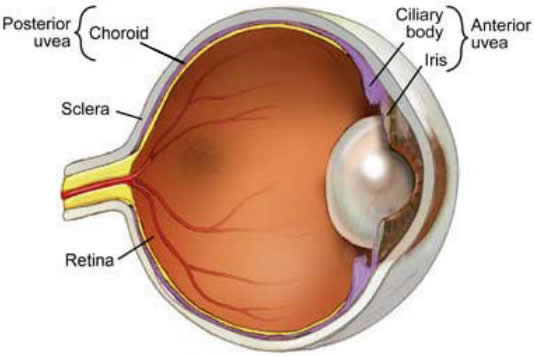How Does Rheumatoid Arthritis Affect the Eyes?
… Continued …
How does rheumatoid arthritis (RA) affect the eyes and cause scleritis?
Inflammatory condition such as rheumatoid arthritis (RA) could make the eye wall (including the sclera) to become thin. This can increase the risk of scleritis, since thinner sclera is easier to split open.
Scleritis linked to RA is often referred to as ‘scleromalacia perorans’, a kind of anterior scleritis. It affects more women than men, especially those with advanced RA.
Anterior scleritis itself means scleritis that involves the sclera at the front of the eye, and it has several types. It is much more common than posterior scleritis (a condition of when the sclera at the back of the eye is involved).
Symptoms
Sleromalacia perorans is not common condition. It is very rare but can be a serious problem to the health of the eyes. Unfortunately, it has no specific symptoms. The onset and progression of the disease can be insidious and slow.
Sleromalacia perorans might not cause any symptom at the onset of the disease. If the early symptoms do occur, they could be similar to those in other types of anterior scleritis such as increased sensitivity to the light, watery eyes, blurred /decreased vision, redness, or severe eye pain.
But again, typically it is often insidious at early stage. There is usually no symptom until something goes awry with the sclera (such as the sclera discoloration) is detected.
Treatment options and prognosis
In the late stages of scleritis, it may coexist with other eye problems such as glaucoma, cataract, anterior uveitis, or even vision loss. These problems could be a consequence of advanced stage of scleritis or due to other causes.
There are many reports about trials of using both medications and surgery to treat sleromalacia perorans. But it’s not clear which one that is completely efficacious!
In a few cases, the use of corticosteroid eye drops is effective enough to control inflammation of scleritis in people with RA. But unfortunately, many times the inflammation is too deep and very difficult to be treated locally.
The existence of scleritis in those with RA can be out of control. The inflammation not only affects the eyes, but it can be found elsewhere in the body, too. If you have RA, controlling it is so important to reduce the risk of its complications!
In arthritis, uveitis is commonly found in juvenile rheumatoid arthritis, an arthritis associated with the immune system abnormality that usually affects children younger than 17 years old. It also can be found in psoriatic arthritis and reactive arthritis.
It is an eye problem that occurs when the inflammation affects the vascular layer called as uvea, located between the sclera and the retina. See the picture below (credit to Mayo):
The symptoms may include blurred vision, eye pain, and more sensitive to the light. If left controlled, advanced uveitis could lead to permanent vision loss – especially for posterior uveitis. Cataracts and glaucoma could be other complications.
See a doctor right away if you notice these symptoms! Early treatment can be so critical to treat it.
In general, the treatment options include the use of corticosteroid (it can be eye drop, taken orally, or directly injected into the eye) and antibiotics (if the infection occurs). If the light intolerance bothers you a lot, wearing dark glasses can help cope with the light sensitivity.
While RA itself can affect the eyes, the use of certain medications for RA poses the risk of some eye problems, too. Fortunately, these medicines are not the main treatments for RA.
One such medicine is hydroxychloroquine. It may pose the risk of damage to the retina, a crucial part of your eyes to process the light coming into the eye. It is not the main choice to treat RA, but sometime it may be prescribed for coping with RA. When you need to take it, you will be suggested to check your retina regularly!
Another medicine that may carry the risk of eye problem is prednisone. It is linked to the risk of glaucoma. Like hydroxychloroquine, it is not the common treatment option for RA. But if RA is difficult to be controlled, prednisone may be prescribed.
In addition, there is also a condition called stye, an eye infection that may occur as a swollen bump. And in severe case, it may pose the risk of developing a condition called orbital cellulitis (an extensive eye swelling that could cause a serious vision loss if it gets worse). Both people with RA or without RA can have stye or/and orbital cellulitis.
- http://www.mayoclinic.org/diseases-conditions/dry-eyes/basics/causes/con-20024129
- http://www.arthritistoday.org/about-arthritis/arthritis-and-your-health/arthritis-and-your-eyes/eye-arthritis.php
- http://www.hss.edu/conditions_rheumatoid-arthritis-eye-concerns.asp
- http://www.webmd.boots.com/eye-health/guide/scleritis
- http://www.nlm.nih.gov/medlineplus/ency/article/001003.htm
- http://omicsonline.org/scleromalacia-perforans-what-we-know-and-what-we-can-do-2155-9570-S2-009.pdf
- http://www.hss.edu/conditions_uveitis-and-other-eye-conditions-in-rheumatology-patients.asp




